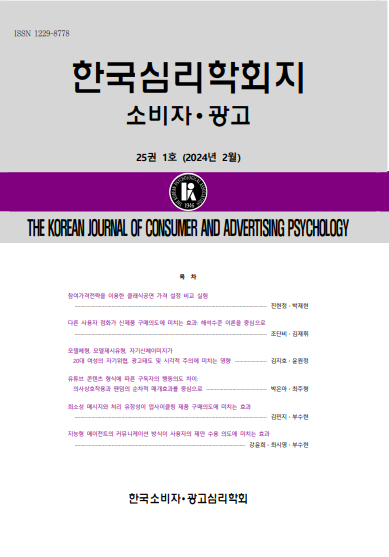open access
메뉴.png)
open access
메뉴 ISSN : 1229-8778
ISSN : 1229-8778
본 연구는 디지털 서비스를 무료로 체험할 수 있음에도 참여가 왜 낮은지에 주목하였다. 체험 프로모션은 제한된 시간 동안 소비되므로 가치를 구체적으로 지각하지 못하면 참여를 꺼려하는 경향이 있는데 디지털 서비스의 경우 소비자가 즉각적으로 효용을 경험하기 힘들다. 따라서, 인지적으로 평가를 하게 하여 가치를 구체적으로 지각할 필요가 있다는 맥락에서 무료보다 사소한 비용이 프로모션의 참여를 높일 수 있다고 예상했다. 이를 위해 연구 1과 2를 통해 사소한 비용이 디지털 서비스에 대해 무료보다 효과적임을 밝히고자 했다. 구체적으로, 연구 1은 사소한 비용의 효과가 선행 연구가 밝혔던 평가 용이성으로 설명될 수 있는지를 보고자 했고 연구 2에서는 본 연구의 예상대로 디지털 서비스에 대해서는 거래 평가를 활성화하여 가치를 인지하기 때문인지를 확인하고자 했다. 본 논문의 결과는 정기 구독의 촉매제로 사용되는 체험 프로모션에 대한 소비자의 참여를 유도해야 할 때, 사소한 비용이라는 실용적인 마케팅 전략을 제안하며 디지털 서비스의 경우 소비자가 가치를 구체적으로 지각하게 해야 한다는 것을 제안해줄 수 있다는 실무적 시사점을 지닌다. 또한, 기존에 잘 다루어지지 않았던 체험 프로모션 맥락에서 참여 의도를 높일 수 있는 심리학적 변수를 보았다는 점에서 이론적 의의를 지닌다.
This study noted why participation is low, even though digital services are free to experience. Experience promotion is consumed for a limited period of time, so people tend to be reluctant to participate if they are not aware of its value in detail, and in the case of digital services, it is difficult for consumers to immediately experience value. Therefore, it was expected that token price rather than free could increase participation in the promotion in the context of the need to be more specifically aware of its value by making cognitive assessments. Therefore, studies 1 and 2 showed that token price were more effective than free for digital services. Specifically, Study 1 revealed that the effect of the token price can’t be explained by the ease of assessment that the preceding study suggested, and Study 2 found that the recognition of value by activating the deal evaluation for digital services mediated token price effect. This study can present a practical marketing strategy of token price when it is necessary to induce consumer participation in the trial promotion used as a catalyst for regular subscriptions. In addition, the theoretical implications can also be found in that, unlike prior research, the way of increasing trial promotion participation have been identified in the psychological field.
이경민, 김대건, & 김재휘 (2019). 공짜보다 할인이 좋아!: 콘텐츠 구독에 대한 프로모션 유형이 참여 의도에 미치는 효과. 한국심리학회 학술대회 자료집, 307-307.
이우빈, & 김재휘 (2019). 단일 대안 제시가 선택 연기에 미치는 효과: 예상되는 후회를 중심으로. 한국심리학회지: 소비자․광고, 20(3), 319-342.
Cheng, H. K., & Liu, Y. (2012). Optimal software free trial strategy: The impact of network externalities and consumer uncertainty. Information Systems Research, 23(2), 488-504.
Cronin Jr, J. J., Brady, M. K., & Hult, G. T. M. (2000). Assessing the effects of quality, value, and customer satisfaction on consumer behavioral intentions in service environments. Journal of retailing, 76(2), 193-218.
Dai, H., Chan, C., & Mogilner, C. (2017). “Don’T Tell Me What to Do!” Shoppers Rely Less on Consumer Reviews For Experiential Than Material Purchases. ACR North American Advances.
Diamond, W. D., & Campbell, L. (1989). The framing of sales promotions: effects on reference price change. ACR North American Advances.
Dunegan, K. J. (1994). Feedback sign and mindful vs. mindless information processing. Advances in managerial cognition and organizational information processing, 5, 315-336.
Gremler, D. D., & Brown, S. W. (1996). Service loyalty: its nature, importance, and implications. Advancing service quality: A global perspective, 5(1), 171-181.
Guiltinan, J. P. (1989). A classification of switching costs with implications for relationship marketing. In AMA winter educators’ conference: Marketing theory and practice (pp. 216-20). Chicago: American Medical Association.
Inman, J. J., Peter, A. C., & Raghubir, P. (1997). Framing the deal: The role of restrictions in accentuating deal value. Journal of Consumer Research, 24(1), 68-79.
Klein, H. J. (1989). An integrated control theory model of work motivation. Academy of Management Review, 14, 150-172.
Kumar, A., & Gilovich, T. (2016). To do or to have, now or later? The preferred consumption profiles of material and experiential purchases. Journal of Consumer Psychology, 26(2), 169-178.
Kuvaas, B., & Selart, M. (2004). Effects of attribute framing on cognitive processing and evaluation. Organizational Behavior and Human Decision Processes, 95(2), 198-207.
Lichtenstein, D. R., Netemeyer, R. G., & Burton, S. (1990). Distinguishing coupon proneness from value consciousness: An acquisition- transaction utility theory perspective. Journal of marketing, 54(3), 54-67.
Mao, W. (2016). Sometimes “fee” is better than “free”: token promotional pricing and consumer reactions to price promotion offering product upgrades. Journal of Retailing, 92(2), 173-184.
Peeters, G., & Czapinski, J. (1990). Positive-negative asymmetry in evaluations: The distinction between affective and informational negativity effects. European review of social psychology, 1(1), 33-60.
Preacher, K. J., & Hayes, A. F. (2008). Asymptotic and resampling strategies for assessing and comparing indirect effects in multiple mediator models. Behavior research methods, 40(3), 879-891.
Sawyer, A. G., & Dickson, P. R. (1984). Psychological perspectives on consumer response to sales promotion. Research on sales promotion: Collected papers, 2.
Schmalensee, R. (1982). Product differentiation advantages of pioneering brands. The American Economic Review, 72(3), 349-365.
Thaler, R. (1985). Mental accounting and consumer choice. Marketing science, 4(3), 199-214.
